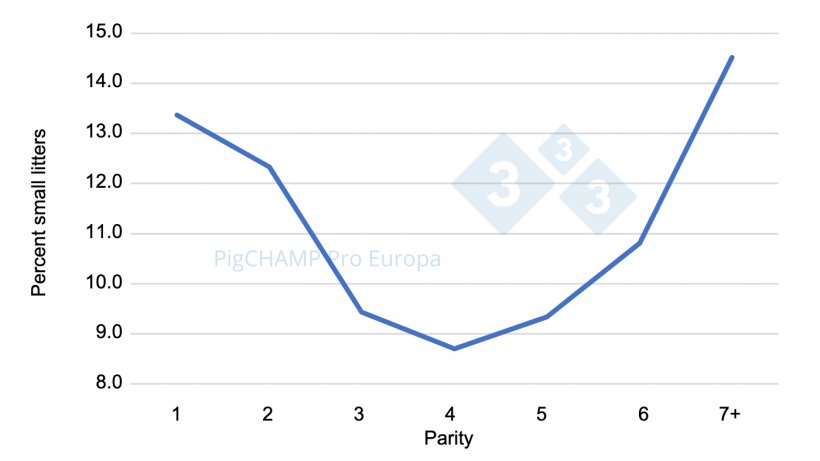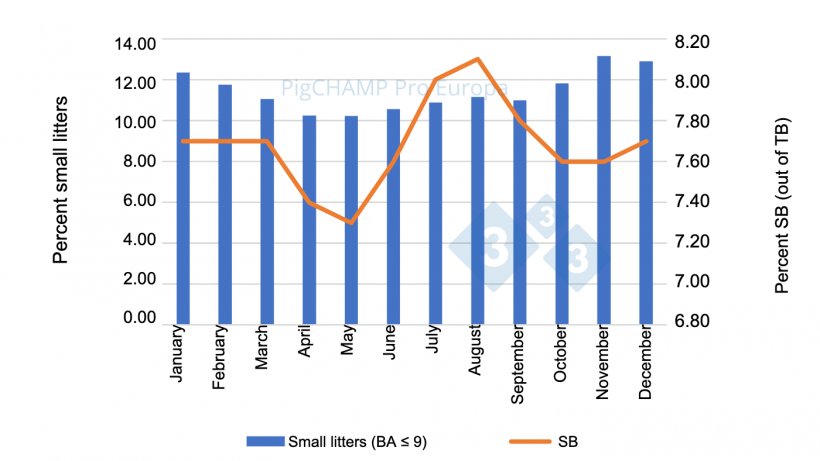The main starting point to achieving good performance in farrowing is undoubtedly good production in terms of piglets born alive (BA). With advances in selection of hyperprolific sows, the production of BA has also been improving in recent years. However, if we analyze the data on our farms, we can observe that there are a certain number of farrowings with a production below 10 piglets born alive. This type of litter has a negative influence on the average BA production on the farm, decreasing in turn the future performance at weaning.
In order to gain an in-depth understanding of this type of litter, we analyzed 1,120,603 farrowings between 2018 and 2019, obtained from the PigCHAMP Pro Europa database. The first thing we observed (Figure 1) is that these litters with lower born alive production (BA≤9 piglets), represent 11.4% of the total litters analyzed.

Figure 1. Percent distribution of litters by size, 2018-2019.

Once we have verified the incidence of these "small litters", we proceed to study their distribution according to sow parity. Figure 2 shows that sows with 7 or more parities produce the highest percentage of small litters, followed by gilts. For sows with 7 or more parities, it is likely that both the drop in prolificacy and the increase in the percentage of stillbirths act as a limiting factor in terms of BA production. On the other hand, it is important to remember that BA production in gilts influences overall sow performance (Lida et al., 2015); hence the importance of minimizing gilts with low BA production.

Figure 2. Percent distribution of small litters (BA ≤ 9 piglets) by parity, 2018-2019.
Another factor that influences the occurrence of smaller litters is seasonality. Figure 3 shows the distribution of stillborn piglets (SB) and the percentage of small litters throughout the year. While the SB values, measured as a percentage of total born (TB), show higher percentages in the summer months (June, July, and August in north hemisphere) the smaller litter sizes tend to increase in November, December and January (late fall/winter months in north hemisphere).

Figure 3. Percent distribution of SB piglets and small litters (BA ≤ 9 piglets), 2018-2019.
According to the previous graph, the percentage increase of smaller litter sizes in the winter months would not be related to a higher incidence of stillborns, since these are higher in summer. Since the limitation on BA production would not be due to a supposed bottleneck exerted by SB, we must look at prolificacy. Figure 4 shows prolificacy in both small and non-small litters. In litters of less than 10 BA, the prolificacy obtained is clearly lower than that shown by litters of 10 or more BA. This would indicate that the reason for these litters being below 10 BA is basically due to the fact that they are litters with low prolificacy and not due to negative effects caused by high percentages of SB and/or mummies.

Figure 4. Box plot representation of the number of total piglets born according to BA litter size, 2018-2019.
In order to minimize the impact of small litters, which seem to have a higher incidence mainly in November and December (late fall/winter months in north hemisphere), we must pay attention to the summer months, since this is when their respective matings take place. In the summer months, sows tend to show worse feeding patterns during lactation, which has a direct impact on a lower quality of follicles (Prunier and Quesnel, 2000); and as a consequence, this translates into smaller litters in the future. These and other aspects related to the influence of feed intake in farrowing on various productive parameters will be discussed in future articles.
Therefore, it is vitally important to take extreme caution, both in daily consumption and intake patterns during lactation, through the use of precision feeding systems. These types of systems are able to adapt to the requirements of the sows at any given moment, minimizing the negative impact caused by the influence of seasonality; and therefore, improving all the reproductive conditioning factors that will influence the characteristics of the litters obtained at the next farrowing.



